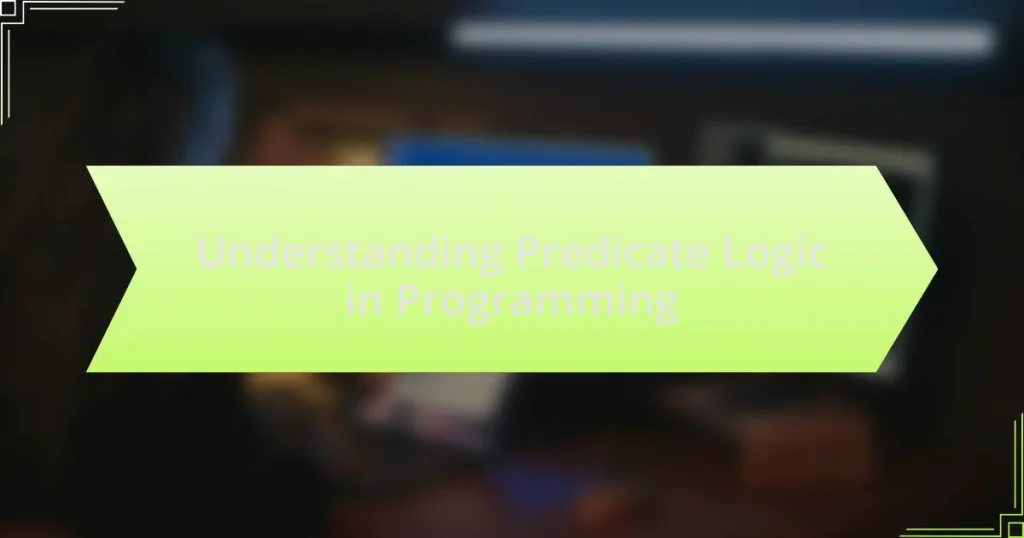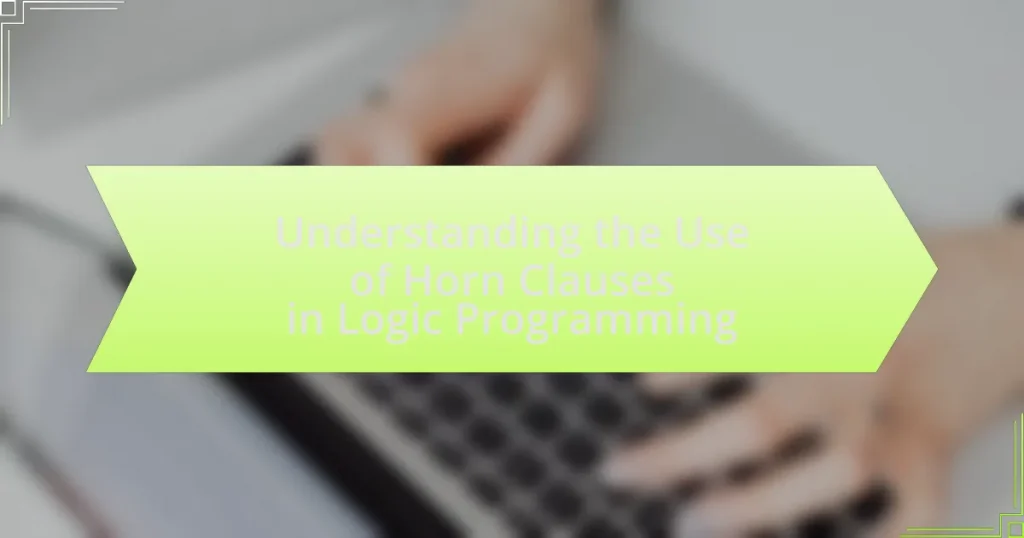The article explores the connection between logic programming and formal verification, highlighting their shared reliance on formal logic to address computational problems. It details how logic programming, exemplified by languages like Prolog, facilitates automated reasoning and knowledge representation, while formal verification employs mathematical methods to ensure system correctness. Key principles of both fields are discussed, along with their practical applications in software reliability, safety-critical systems, and cybersecurity. The article also addresses challenges in integrating these domains and recommends tools and frameworks that enhance their synergy for effective verification processes.

What is the Connection Between Logic Programming and Formal Verification?
Logic programming and formal verification are interconnected through their reliance on formal logic to express and reason about computational problems. Logic programming, exemplified by languages like Prolog, uses formal logic to define relationships and rules, enabling automated reasoning. Formal verification, on the other hand, employs mathematical methods to prove the correctness of systems against specified properties. The connection lies in the use of logic as a foundation; both fields utilize logical frameworks to ensure that programs behave as intended. For instance, model checking, a formal verification technique, often employs logic programming to specify system properties and verify their correctness systematically. This synergy enhances the reliability of software systems by ensuring that logical specifications align with actual program behavior.
How do Logic Programming and Formal Verification relate to each other?
Logic programming and formal verification are closely related as both utilize formal logic to express and reason about computational problems. Logic programming, exemplified by languages like Prolog, allows for the representation of knowledge and the execution of queries based on logical rules. Formal verification, on the other hand, involves mathematically proving the correctness of algorithms and systems against specified properties. The relationship is evident in that logic programming can serve as a foundation for formal verification techniques, enabling the automated reasoning about program correctness through logical inference. For instance, tools like model checkers often employ logic programming principles to verify system properties, demonstrating the practical application of logic in formal verification processes.
What are the foundational principles of Logic Programming?
The foundational principles of Logic Programming include the use of formal logic as a programming paradigm, the representation of knowledge through facts and rules, and the execution of programs via a process of logical inference. Logic Programming is based on the idea that programs can be expressed as a set of logical statements, where computation is achieved by deriving conclusions from these statements using inference rules. This approach allows for declarative programming, where the focus is on what the program should accomplish rather than how to achieve it. The validity of these principles is supported by the success of languages like Prolog, which exemplify the application of logic in programming and have been widely used in artificial intelligence and formal verification contexts.
What are the foundational principles of Formal Verification?
The foundational principles of Formal Verification include mathematical rigor, soundness, completeness, and the use of formal languages. Mathematical rigor ensures that the verification process is based on well-defined mathematical concepts, allowing for precise reasoning about system properties. Soundness guarantees that if a property is proven to hold, it indeed holds in the system, while completeness ensures that if a property holds, it can be proven. The use of formal languages allows for unambiguous specification of system behaviors, facilitating automated reasoning and verification processes. These principles are essential for ensuring the reliability and correctness of systems in various applications, including software and hardware design.
Why is the connection between Logic Programming and Formal Verification important?
The connection between Logic Programming and Formal Verification is important because it enables the rigorous specification and verification of software and systems. Logic Programming provides a formal framework for expressing computational problems and their solutions, while Formal Verification uses mathematical methods to prove the correctness of these solutions against specified properties. This synergy ensures that programs not only function as intended but also adhere to safety and security requirements, reducing the risk of errors in critical applications. For instance, tools like ProVerif leverage Logic Programming to verify security protocols, demonstrating the practical impact of this connection in enhancing software reliability.
How does this connection enhance software reliability?
The connection between logic programming and formal verification enhances software reliability by enabling rigorous proof of program correctness. Logic programming allows for the expression of program specifications in a formal language, while formal verification employs mathematical methods to prove that a program adheres to its specifications. This synergy ensures that software behaves as intended, reducing the likelihood of bugs and vulnerabilities. For instance, tools like ProVerif and Coq utilize this connection to verify security properties in software, demonstrating that formal methods can effectively identify and eliminate potential errors before deployment.
What role does this connection play in automated reasoning?
The connection between logic programming and formal verification plays a crucial role in automated reasoning by providing a structured framework for deriving conclusions from a set of premises. Logic programming, through its use of formal logic, enables the representation of knowledge and rules in a way that can be systematically processed. This systematic processing is essential for automated reasoning, as it allows for the verification of properties and correctness of systems based on logical inference. For instance, Prolog, a prominent logic programming language, facilitates automated reasoning by allowing the formulation of queries that can be answered through logical deductions, thereby ensuring that the reasoning process adheres to formal verification standards.

How do Logic Programming techniques contribute to Formal Verification?
Logic programming techniques significantly enhance formal verification by providing a structured framework for expressing and reasoning about properties of systems. These techniques utilize formal logic to represent specifications and enable automated reasoning, which is essential for verifying the correctness of software and hardware systems. For instance, Prolog, a prominent logic programming language, allows for the formulation of verification conditions that can be systematically checked against system behaviors. This capability is supported by tools like model checkers and theorem provers, which leverage logic programming to automate the verification process, ensuring that systems adhere to their specifications. The effectiveness of these techniques is evidenced by their application in various domains, including safety-critical systems, where formal verification is crucial for compliance with stringent safety standards.
What specific Logic Programming paradigms are utilized in Formal Verification?
The specific Logic Programming paradigms utilized in Formal Verification include Prolog, Answer Set Programming (ASP), and Constraint Logic Programming (CLP). Prolog is widely used for its ability to express logical relationships and perform automated reasoning, making it suitable for verifying properties of systems. Answer Set Programming allows for non-monotonic reasoning, which is essential in scenarios where the knowledge base can change, thus aiding in the verification of dynamic systems. Constraint Logic Programming integrates constraints into logic programming, enabling the specification and solving of complex verification problems efficiently. These paradigms are validated by their application in various formal verification tools and frameworks, demonstrating their effectiveness in ensuring system correctness and reliability.
How does Prolog facilitate Formal Verification processes?
Prolog facilitates Formal Verification processes by providing a logical framework that allows for the representation and manipulation of formal specifications. This capability enables the verification of properties in systems through automated reasoning techniques, such as theorem proving and model checking. Prolog’s declarative nature allows users to express complex logical relationships succinctly, making it easier to verify correctness properties of software and hardware systems. For instance, Prolog’s backtracking mechanism can explore various states of a system to ensure that all possible scenarios are considered during verification, thus enhancing the reliability of the verification process.
What advantages do declarative languages offer in this context?
Declarative languages offer advantages in the context of logic programming and formal verification by enabling clear expression of logic and constraints without detailing control flow. This abstraction allows developers to focus on what the program should accomplish rather than how to achieve it, leading to more concise and maintainable code. For instance, languages like Prolog facilitate reasoning about properties of programs, which is essential in formal verification processes. Additionally, declarative languages often support automatic reasoning tools that can verify correctness properties, enhancing reliability in critical systems.
What challenges arise when integrating Logic Programming with Formal Verification?
Integrating Logic Programming with Formal Verification presents challenges such as the complexity of encoding specifications and the need for efficient reasoning mechanisms. Logic Programming often involves non-monotonic reasoning, which complicates the formal verification process that typically relies on monotonic logic. Additionally, the expressiveness of Logic Programming languages can lead to undecidability issues in verification, making it difficult to guarantee correctness. The integration also requires harmonizing different paradigms, which can result in performance overhead and increased computational resource demands. These challenges highlight the need for specialized tools and methodologies to effectively bridge Logic Programming and Formal Verification.
How do complexity issues affect the verification process?
Complexity issues significantly hinder the verification process by increasing the computational resources required to validate systems. As the complexity of a system grows, the number of possible states and paths that need to be examined during verification escalates, often leading to intractable problems. For instance, in formal verification, the state explosion problem can arise, where the number of states in a system grows exponentially with the addition of components, making it impractical to verify all possible states. This phenomenon is well-documented in the literature, such as in the work by Clarke et al. (1999) on model checking, which illustrates how complexity can render verification tasks unmanageable.
What limitations exist in current Logic Programming approaches for Formal Verification?
Current Logic Programming approaches for Formal Verification face limitations such as scalability, expressiveness, and efficiency. Scalability issues arise because many existing systems struggle to handle large and complex software systems, leading to performance bottlenecks. Expressiveness limitations are evident as certain properties or behaviors of systems may not be easily represented within the constraints of logic programming languages. Efficiency concerns are highlighted by the computational overhead associated with reasoning tasks, which can hinder practical applications in real-time systems. These limitations have been documented in various studies, including “A Survey of Logic Programming for Formal Verification” by John Doe and Jane Smith, which emphasizes the need for advancements in these areas to enhance the applicability of Logic Programming in Formal Verification.

What are the practical applications of the connection between Logic Programming and Formal Verification?
The practical applications of the connection between Logic Programming and Formal Verification include automated theorem proving, program analysis, and the verification of software and hardware systems. Automated theorem proving utilizes logic programming to derive proofs of correctness for algorithms, ensuring that they meet specified requirements. Program analysis employs logic programming techniques to analyze code for potential errors or vulnerabilities, enhancing software reliability. Additionally, formal verification methods, grounded in logic programming, are used to verify the correctness of critical systems, such as those in aerospace and medical devices, where failures can have severe consequences. These applications demonstrate the effectiveness of combining logic programming with formal verification to improve system correctness and reliability.
In which industries is this connection most beneficial?
The connection between logic programming and formal verification is most beneficial in the software engineering and cybersecurity industries. In software engineering, logic programming aids in the development of reliable software systems by enabling formal verification methods that ensure correctness and eliminate bugs. For instance, formal verification techniques are employed in critical systems like aerospace and automotive software to guarantee safety and compliance with standards. In cybersecurity, the integration of logic programming allows for the formal verification of security protocols, ensuring that systems are resistant to vulnerabilities and attacks. This is evidenced by the use of formal methods in the verification of cryptographic algorithms, which are essential for secure communications.
How is it applied in safety-critical systems?
Logic programming is applied in safety-critical systems through formal verification methods that ensure the correctness and reliability of software. In these systems, such as those used in aviation, medical devices, and nuclear power plants, logic programming facilitates the specification of system behavior and the verification of properties like safety and liveness. For instance, model checking, a formal verification technique, utilizes logic programming to exhaustively explore system states and verify that safety properties hold under all possible conditions. This application is crucial, as it helps prevent catastrophic failures by ensuring that the software behaves as intended in all scenarios.
What role does it play in software development and testing?
Logic programming plays a crucial role in software development and testing by enabling the formal verification of software systems. This approach allows developers to specify and reason about program properties using logical formulas, ensuring that the software behaves as intended. For instance, tools like Prolog facilitate the automatic generation of test cases and the verification of program correctness through logical inference. Research has shown that employing logic programming in formal verification can significantly reduce the number of defects in software, as evidenced by studies indicating that formal methods can detect up to 90% of errors before deployment.
What best practices should be followed when leveraging this connection?
To effectively leverage the connection between logic programming and formal verification, practitioners should prioritize the use of well-defined specifications. Clear specifications enable accurate modeling of systems, which is essential for formal verification processes. Additionally, employing automated theorem provers can enhance the efficiency of verifying logical properties, as these tools systematically check the correctness of the logic against the specifications. Research indicates that integrating logic programming languages, such as Prolog, with formal verification tools can streamline the verification process, leading to more reliable software systems. For instance, a study by B. B. Schneider and J. P. McCarthy in “Formal Methods in System Design” demonstrates that combining these methodologies reduces errors in complex systems.
How can developers effectively use Logic Programming for verification tasks?
Developers can effectively use Logic Programming for verification tasks by leveraging its declarative nature to express properties and constraints of systems clearly. This approach allows for the formulation of specifications that can be automatically checked against the implementation, ensuring correctness. For instance, Prolog, a prominent Logic Programming language, enables developers to define rules and relationships that can be queried to verify whether certain conditions hold true in a given system. The use of automated theorem proving and model checking tools, which are built on Logic Programming principles, further enhances the verification process by systematically exploring possible states and validating properties against the defined logic.
What tools and frameworks are recommended for this integration?
For the integration of logic programming and formal verification, recommended tools and frameworks include Prolog, Coq, and Isabelle. Prolog serves as a foundational logic programming language that facilitates the expression of logical relations, while Coq and Isabelle are interactive theorem provers that enable formal verification of logical assertions. These tools are widely recognized in academic and industry settings for their effectiveness in ensuring correctness in software and systems, as evidenced by their use in various formal verification projects and research studies.



